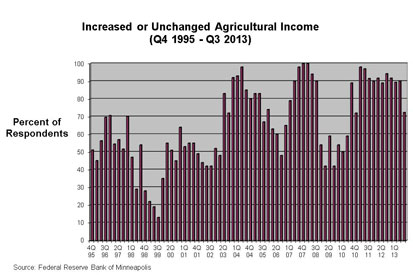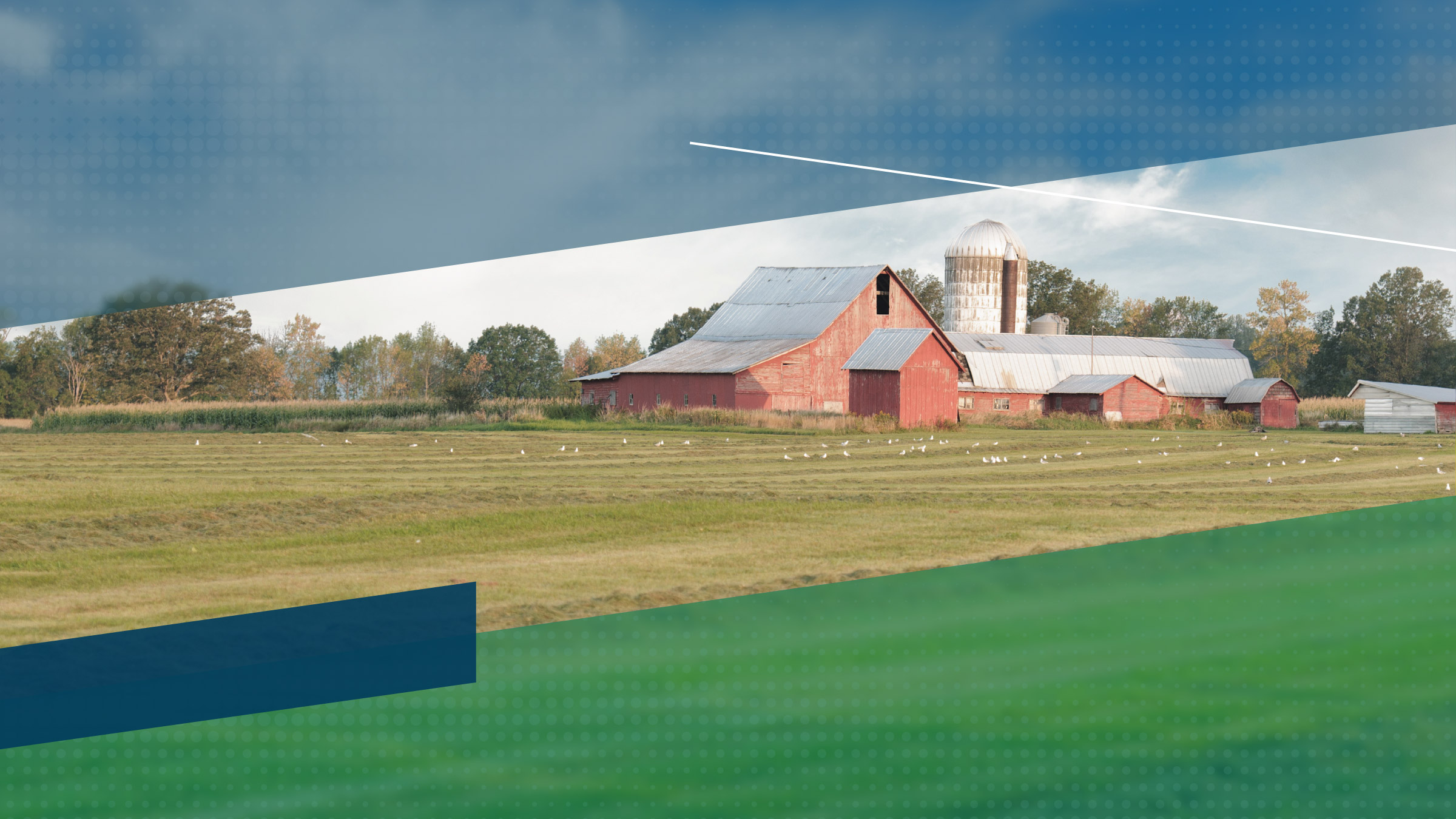The erratic weather in 2013 made it a tough growing season for farmers. A lender in Wisconsin summed up the year: “Wet spring delayed planting and then a lack of moisture to finish the crop.” Along with lousy weather, a decline in commodity prices dealt a financial blow to farmers from July through September 2013, according to the Minneapolis Fed’s third-quarter (October) agricultural credit conditions survey. Land values increased further across district states, and interest rates on loans increased slightly from the last quarter. The outlook for the fourth quarter is similar, with all states in the district expecting farm incomes to decrease or stay the same.
Farm income, household spending and capital investment
“Commodity prices appear to be lower,” commented a South Dakota ag banker. Farm income could be 10 percent to 15 percent lower than 2012. Based on the survey results, this assessment was widespread around the region.
More than a quarter of district lenders surveyed reported that farm incomes decreased in the third quarter of 2013 from the previous quarter, while 15 percent said that incomes increased (see chart). Even North Dakota, which experienced the most widespread increase in income in the district, saw only 35 percent of respondents report higher farm income. Household spending within the district was flat, with nearly three-quarters of lenders reporting no change; only 6 percent said it decreased. Capital spending was more mixed—about half of respondents said it was flat and of the remainder, slightly more reported decreases than increases.
Lenders in Minnesota and Wisconsin, where weather this growing season was particularly volatile, were less optimistic than lenders in other states. In Minnesota, 93 percent of those surveyed said farm income decreased or was flat, while in Wisconsin none reported increases (half said it decreased and half noted no change). Looking forward to the fourth quarter, no respondents in either state were predicting increases in income.
Loan repayments and renewals
Despite the financial downturn, agricultural producers in the district are maintaining their rate of loan repayments, and renewals are similarly holding steady. Loan repayments were unchanged for 80 percent of respondents, while only 3 percent reported that repayment rates decreased. A majority of lenders, 85 percent, stated that the number of renewals has held steady, and 10 percent reported a lower number of renewals.
Demand for loans, required collateral and interest rates
Farm households apparently remain flush with cash, as their demand for loans correspondingly fell slightly from the last survey. Almost 57 percent of lenders experienced no change in loan demand, and 22 percent indicated that loan demand has decreased. The amount of required collateral remained flat, with 89 percent of respondents reporting no change. Both fixed and variable interest rates on operating, machinery and real estate loans decreased somewhat from the previous quarter.
Cash rents and land values
The recent trend of rising land values continued, but appears to have slowed. Average values for nonirrigated and irrigated cropland as well as ranchland in the district all increased from a year earlier, according to survey respondents. However, compared with the second quarter, values for nonirrigated farmland increased less than 1 percent for the district as a whole, in contrast to the 18 percent annual rate of increase. Cash rents for the same land increased 8 percent for the district but fell slightly on a quarterly basis, though the picture varies by state. Around the district, the largest annual growth was for irrigated farmland, which increased in value by 23 percent, while cash rents for it rose by 16 percent. Ranchland increased in value by 16 percent and also posted a 12 percent increase in cash rents. Nonirrigated land values in North Dakota increased the most, at 35 percent, and irrigated land in South Dakota rose a whopping 40 percent. North Dakota also saw the biggest increases in land rents, while rental rates for Montana ranchland increased 24 percent. However, the market may have changed, as one North Dakota lender noted, “Higher interest rates and lower commodity prices will put the brakes on high land prices.”
Outlook
Expectations for the final quarter of 2013 are slightly pessimistic generally, as a lender from South Dakota reported, “With lower crop prices and lower yields, farm income will be down this year compared to 2012.” Across the district, 48 percent of lenders predicted that farm income will decrease, compared with 16 percent forecasting increases. Expectations for household and capital spending are slightly better, with 17 percent and 34 percent expecting decreases, respectively. Loan demand was largely expected to remain unchanged in the upcoming quarter, along with repayments, renewals and the amount of required collateral.
Animal products were the bright side of the agricultural sector. As a South Dakota respondent noted, “Cattle prices continue to be good.” And since they use crops as a feed input, lower crop prices are good news to livestock and dairy producers.
Appendices:
Joe Mahon is a Minneapolis Fed regional outreach director. Joe’s primary responsibilities involve tracking several sectors of the Ninth District economy, including agriculture, manufacturing, energy, and mining.






